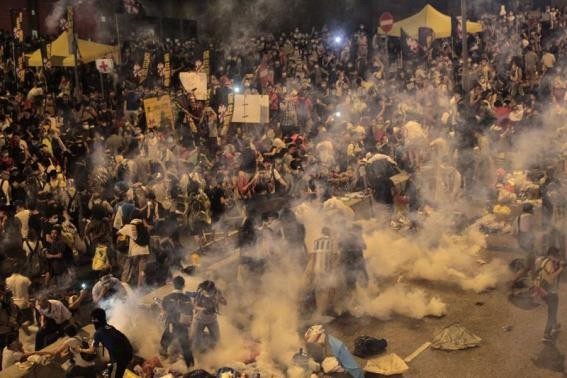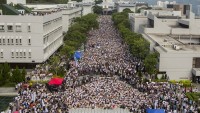Hong Kong Police Use Tear Gas and Pepper Spray to Disperse Protesters
| Ren Benavidez | | Sep 28, 2014 01:20 PM EDT |
(Photo : REUTERS/STRINGER) Protesters flee from teargas fired by riot police, during clashes after thousands of protesters blocked the main street to the financial Central district outside the government headquarters in Hong Kong September 28, 2014.
The Hong Kong police on Sunday resorted to using tear gas and pepper spray to disperse thousands of pro-democracy demonstrators who blocked a key road in the government district.
Hong Kong's Admiralty district resembled a war zone as over 30,000 people joined the protest, which blocked several of the city's roads, causing authorities to divert a number of bus routes.
Like Us on Facebook
Protesters who tried to go through the police barricades were pepper sprayed.
In the afternoon, the authorities fired volleys of tear gas at least three times in an attempt to disperse the crowd following police warnings regarding illegal demonstrations.
The crowd scattered following the attacks and looked for water, paper towels and many covered themselves with umbrellas, while calling the authorities "cowards."
However, the demonstrators returned, and by early evening, tens of thousand protesters have again gathered outside the Pacific Place mall, on their way to city's main financial district.
The demonstrators wee again attacked by tear gas and were sent from Admiralty towards Central.
According to Alvin Au, a teacher who was at the demonstration to look after his students, although they knew there were tear gas and pepper spray, they didn't imagine it would be used on them.
"It's beyond our imagination and toleration. The government is becoming irrational," Au said.
Authorities reported there were 34 injured protesters, including 11 government employees and four police officers.
The Hong Kong police has not used tear gas or pepper sprays since 2005, when they were trying to disperse a crowd of World Trade Organization demonstrators, which gathered to protest against the South Korean farmers
According to Benny Tai, the leader of the movement called Occupy Central, the number of people who joined the protest was "unexpected."
Occupy Central's original plan was to take over the central business district next Wednesday, but was changed and movement organizers decided on joining the mass sit-in of student protesters.
In 1997, Hong Kong returned to Chinese rule after years of being under the British rule.
Hong Kong returned to China under a "one country, two systems rule, which guaranteed Hong Kong's autonomy from mainland china.
However, the conflict began when China announced that Hong Kong will not be able to choose its own leader.
The announcement followed a number of protests from pro-democracy groups who are fighting for the city's autonomy and sovereignty.
©2015 Chinatopix All rights reserved. Do not reproduce without permission
EDITOR'S PICKS
-

Did the Trump administration just announce plans for a trade war with ‘hostile’ China and Russia?
-

US Senate passes Taiwan travel bill slammed by China
-

As Yan Sihong’s family grieves, here are other Chinese students who went missing abroad. Some have never been found
-

Beijing blasts Western critics who ‘smear China’ with the term sharp power
-

China Envoy Seeks to Defuse Tensions With U.S. as a Trade War Brews
-

Singapore's Deputy PM Provides Bitcoin Vote of Confidence Amid China's Blanket Bans
-

China warns investors over risks in overseas virtual currency trading
-

Chinese government most trustworthy: survey
-

Kashima Antlers On Course For Back-To-Back Titles
MOST POPULAR
LATEST NEWS
Zhou Yongkang: China's Former Security Chief Sentenced to Life in Prison

China's former Chief of the Ministry of Public Security, Zhou Yongkang, has been given a life sentence after he was found guilty of abusing his office, bribery and deliberately ... Full Article
TRENDING STORY

China Pork Prices Expected to Stabilize As The Supplies Recover

Elephone P9000 Smartphone is now on Sale on Amazon India

There's a Big Chance Cliffhangers Won't Still Be Resolved When Grey's Anatomy Season 13 Returns

Supreme Court Ruled on Samsung vs Apple Dispute for Patent Infringement

Microsoft Surface Pro 5 Rumors and Release Date: What is the Latest?











